Back when I was first learning how to fly, there was a single Federal Aviation Administration (FAA) Rotorcraft Flying Handbook that covered both helicopters and gyroplanes. I dutifully memorized the helicopter section of the handbook, but can’t recall even looking at the gyroplane portion — maybe I had enough to learn as it was, and didn’t want to risk mixing up my rotorcraft.

In subsequent years, the only time I thought about gyroplanes was after an acquaintance was killed flying one, which was hardly a positive association. And my general disinterest in the machines wasn’t unusual. Most helicopter pilots I know think of gyroplanes as an inferior sort of rotorcraft; a poor substitute for being able to hover. Given how many homebuilt gyroplanes resemble barely airworthy garage projects, can you really blame them?
My own attitudes about gyroplanes didn’t change until earlier this year, when I was given the opportunity to train in the Magni M16 with Michael Trudell, a corporate pilot and instructor at Orbic Helicopters in Camarillo, California. In the U.S., the Italian-made M16, like most other gyroplanes, is only available as a kit, but it comes factory-built in some other countries and is at least as serious of an aircraft as the Robinson R22 in which I did my primary helicopter training. Trudell, for his part, is the consummate professional pilot, as safe and skillful when he’s buzzing around in his gyroplane as when he’s transporting VIPs under instrument flight rules in a Leonardo AW169.

These obviously high standards of airworthiness and professionalism immediately set me at ease — and allowed me to discover how truly fun gyroplanes are. No, they can’t hover, but they can do almost everything else a helicopter can do, with no danger of low-rpm blade stall. And in open-cockpit models like the tandem-seat M16, the sheer experience of flying is purer and more thrilling than anything I’ve ever felt in a helicopter.
Maybe gyroplanes aren’t an inferior sort of rotorcraft after all.
The original innovation
Although helicopters would come to eclipse them, gyroplanes actually pre-date practical helicopters by nearly two decades. The first successful autogyro (as gyroplanes were initially known) was the C.4 designed by the Spanish engineer Juan de la Cierva, which made its first flight in January 1923. By contrast, Igor Sikorsky’s VS-300 helicopter wouldn’t take to the air in free flight until May 1940.
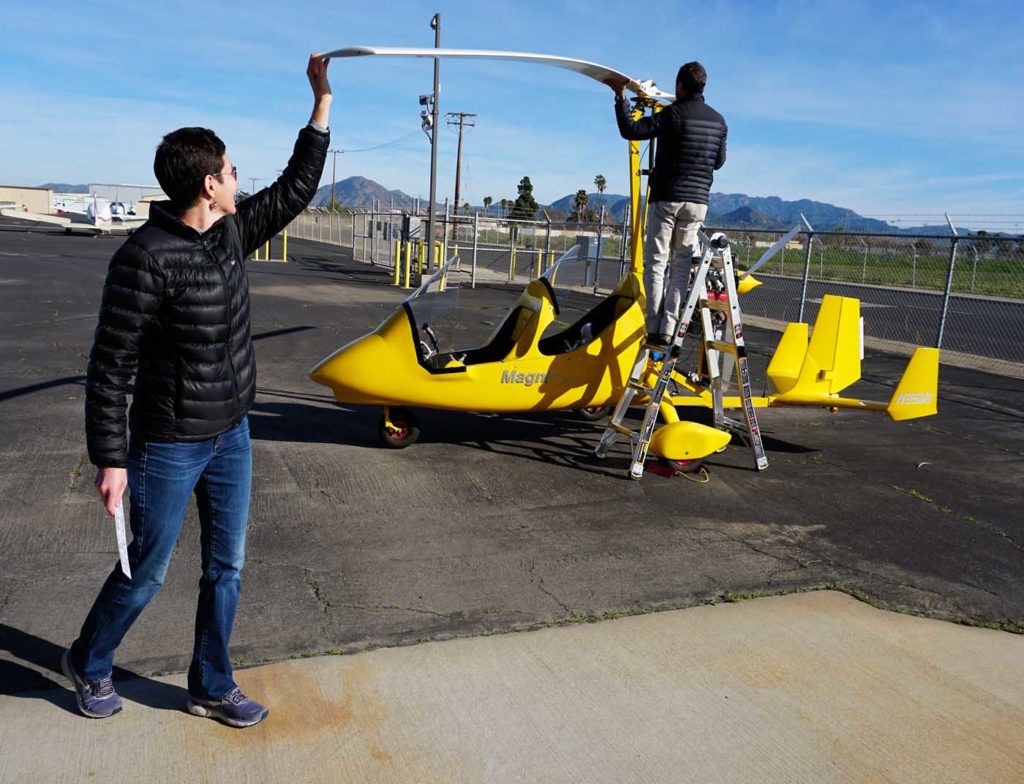
De la Cierva’s breakthrough invention was an articulated rotor system that solved the control problem associated with dissymmetry of lift in forward flight. His earlier models rolled when attempting takeoff because more lift was created on the advancing half of the rotor disc — where forward airspeed adds to the airflow created by blade rotation — than on the retreating half, where it subtracts. In an articulated rotor system, a flapping hinge allows the blades to flap up on the advancing side and down on the retreating side, changing their angles of attack in ways that automatically equalize lift across the rotor disc. Of course, this principle is fundamental to the successful control of helicopters as well, so the entire rotorcraft industry is in de la Cierva’s debt.
In a helicopter, the main rotor system is normally driven by the engine, and the blades generate both lift and thrust. A clutch permits the blades to spin freely — i.e., autorotate — in the event of a power failure. In an autorotation, air flowing up through the rotor blades provides a driving force that keeps the blades rotating and generating enough lift to control the aircraft on the way to the ground — which is where you’re headed in the absence of an external source of thrust.
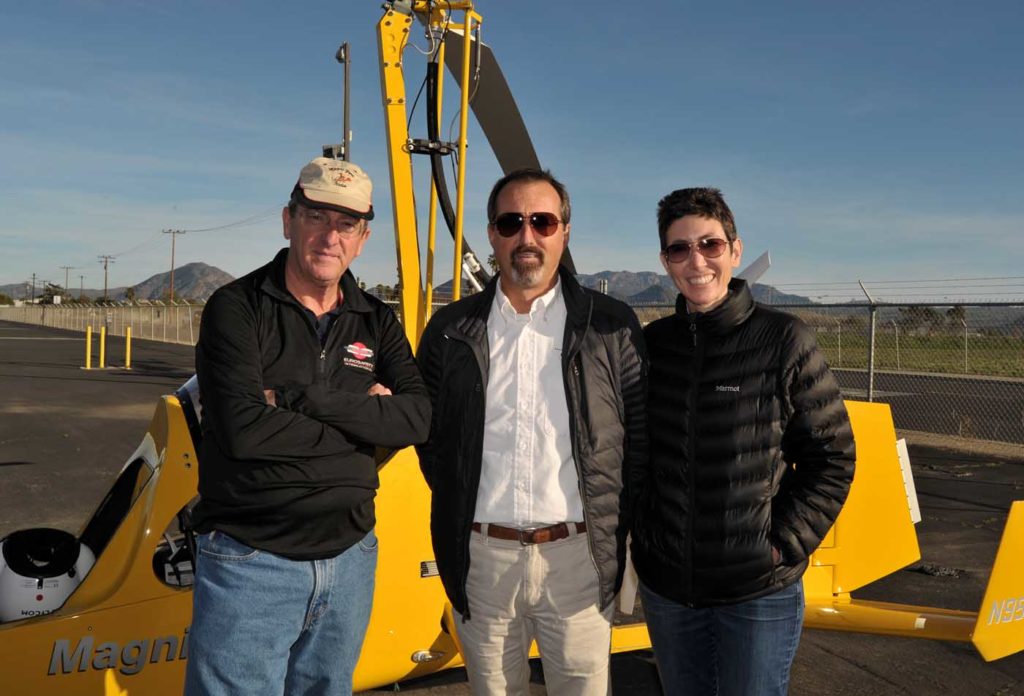
In a gyroplane, the main rotor blades are in autorotation all the time and produce only lift. Thrust comes from a propeller that is commonly mounted in the rear of the aircraft, as it is in the M16. Like most gyroplanes these days, the M16 has a mechanical “prerotator” system that helps accelerate the rotor blades from a standstill while the aircraft is on the ground. Early gyroplanes required the pilot to manually start the rotor blades spinning, then bring them up to takeoff rpm through a long ground roll with the rotor disc tilted aft. (While no longer necessary, this ground roll is something I practiced with Trudell to better understand the dynamics of rotor management.)
Like helicopters, gyroplanes have a cyclic control that controls the tilt of the rotor disc to command pitch and bank, although this is done through physically tilting the rotor hub with push-pull tubes, rather than cyclically altering blade pitch via a swashplate. Only gyroplanes with jump takeoff capability have a helicopter-style collective control that changes the pitch of all rotor blades simultaneously; the M16 does not. Its other flight controls are a left-side-mounted throttle that controls the rpm of the pusher prop, and pedals that provide nose-wheel steering on the ground and rudder control in the air.
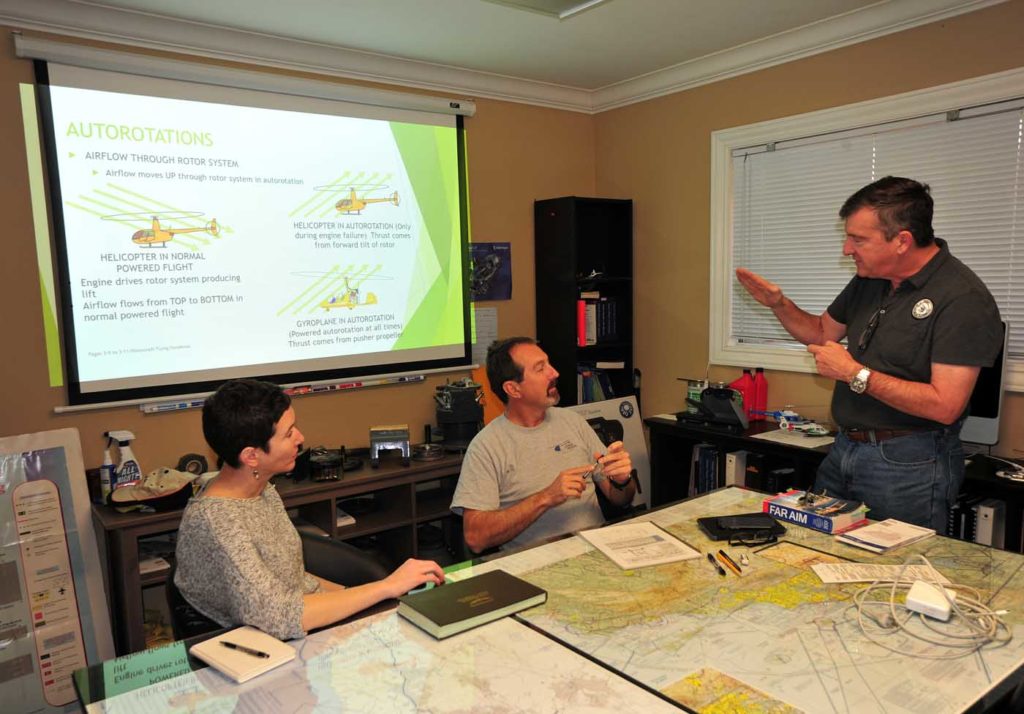
A primary concern for any gyroplane design is stability. This is a complex (and somewhat controversial) subject and is influenced by a number of factors, including the relation of the propeller thrust line and the rotor force line to the location of the center of gravity (CG). Some early gyroplanes lacked horizontal stabilizers, but they’re now a standard feature for increasing dynamic stability by damping oscillations produced by overcontrolling or turbulence.
A distinguishing characteristic of Magni gyroplanes is what their proponents call a “big tail way back” — or what the M16 flight manual describes as “generous horizontal and vertical airfoil section stabilizer surfaces,” mounted well aft of the aircraft’s CG. While I don’t have the experience to compare the M16 to other gyroplanes, I can attest that it has very docile handling characteristics; something that is, of course, particularly welcome in a trainer.
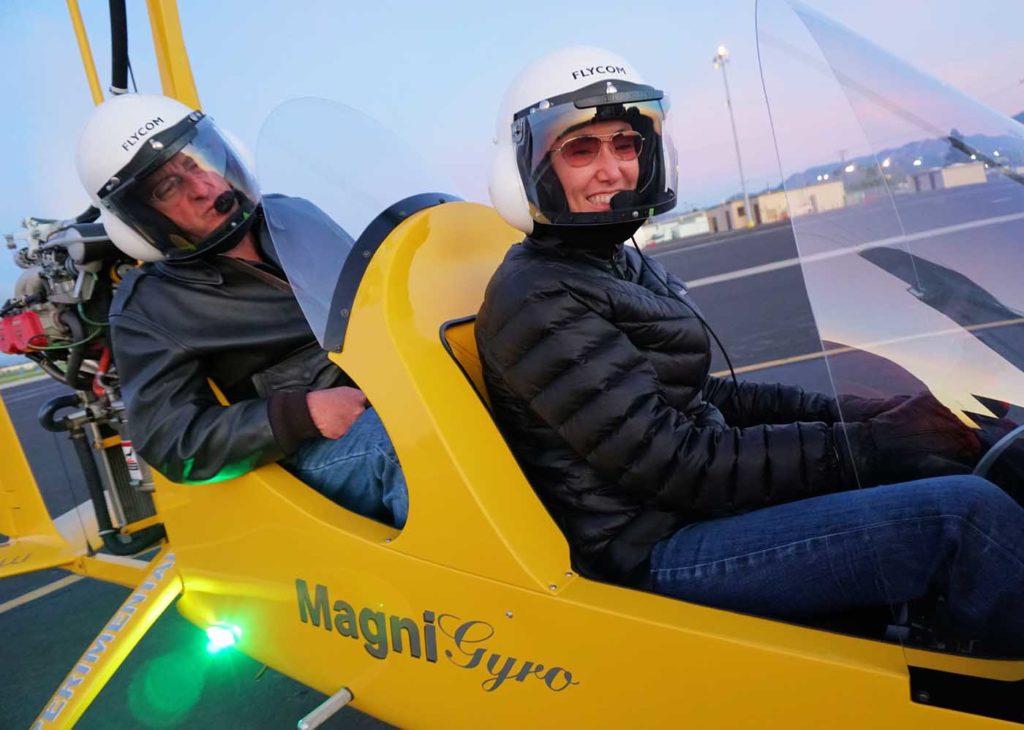
Getting to know the Magni
In the U.S., there’s no minimum flight hour requirement for a certified rotorcraft – helicopter pilot seeking to add a gyroplane class rating. Trudell has found that most experienced helicopter pilots can achieve proficiency in gyroplanes in just 15 hours or less, so he proposed that I train for either a private or commercial add-on rating, depending on how much time I could devote to it.
When I showed up in Camarillo in January, my first task was to get acquainted with the aircraft that I knew only through my preliminary study of the flight manual. Seeing the M16 in person for the first time, I was immediately impressed. Not that there was anything fancy about it; a gyroplane is a rotorcraft reduced to its bare essence. But the well-built frame and quality components signaled that it was a “real” aircraft, and Trudell — a conscientious owner-mechanic who assembled his M16 under supervision at the Magni factory in Italy — clearly kept it in top condition.
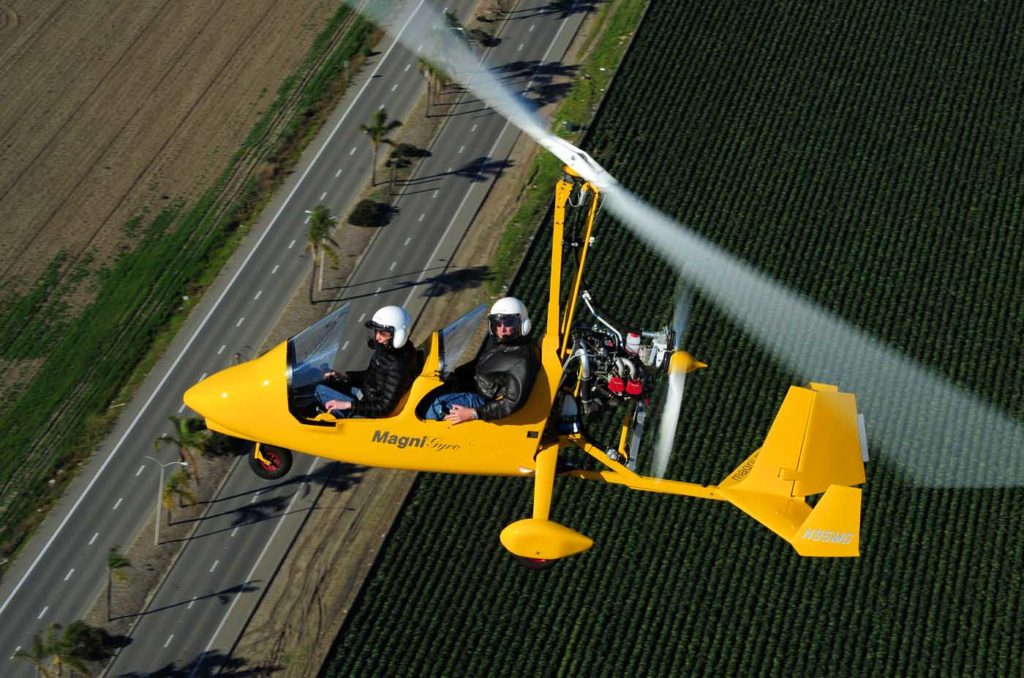
(Ordinarily, the owner of an experimental homebuilt aircraft like this one would be prohibited from operating it for hire, but Trudell has secured the necessary FAA permissions to use it for commercial flight instruction.)
At 1,212 pounds (550 kilograms), the M16’s maximum gross weight is fairly close to that of the R22, which tops out at 1,370 lb. (622 kg). Its rotor diameter is actually larger than that of the R22, at 28 feet (8.5 meters) versus 25 feet (7.6 m). However, without the R22’s long tail boom, its overall length is substantially shorter, even with its tandem cockpit, and its empty weight is just shy of 600 lb. (270 kg), a couple hundred pounds less than the typical empty weight of an R22.
Trudell’s M16 is powered by a turbocharged, four-cylinder Rotax 914 engine that generates a maximum 115 horsepower (a 100-hp Rotax 912 option is also available). Automotive gasoline with a minimum octane rating of 90 is the preferred fuel, although it’s capable of using 100 low-lead avgas with limitations. With an average fuel burn of 5.4 gallons (20 liters) per hour, its 17 gal (65 L) of usable fuel will keep it aloft for at least three hours.
Once Trudell had taken me through a thorough preflight, we strapped in for my first flight, with me up front in the pilot-in-command’s seat. He talked me through the engine start and run-up procedures, and then narrated his takeoff procedure before handing the controls back to me a few hundred feet off the ground. I already had a huge grin on my face by that point — the experience of taking off in the open air was exhilarating.
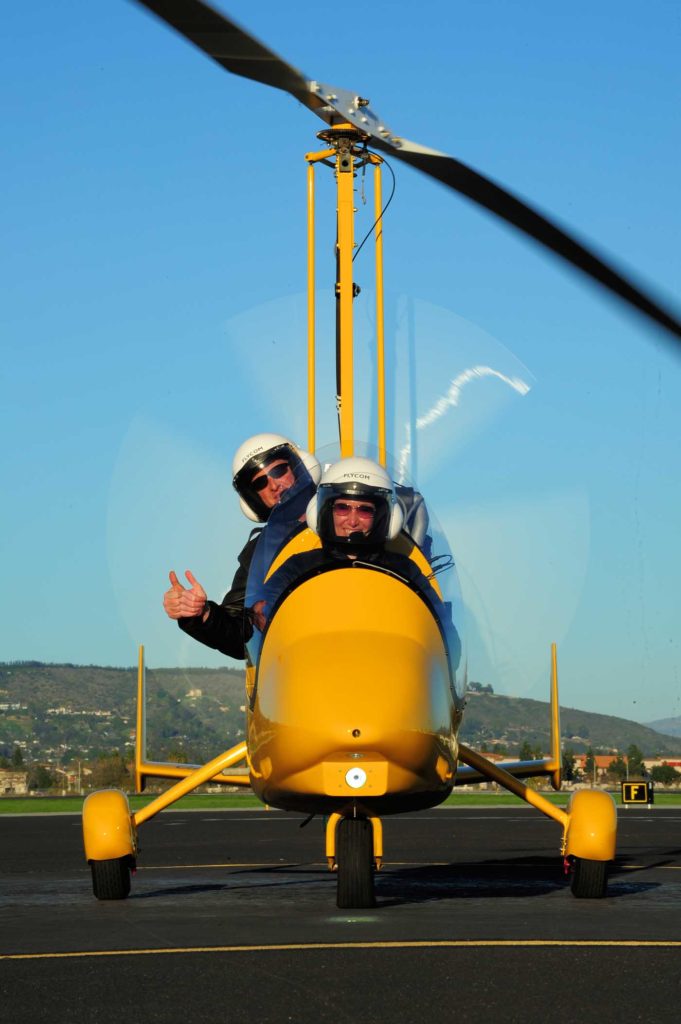
I quickly discovered that handling the Magni at altitude was no big deal, with the cyclic operating just like a helicopter cyclic, and the throttle functioning very much like a helicopter collective. Trudell demonstrated how we could slow to below 30 miles per hour while maintaining level flight (the precise point at which the aircraft can no longer sustain level flight is based on weight, so your results may vary). Even when we slowed to zero forward airspeed, our descent wasn’t precipitous, and easily recoverable by adding forward cyclic to gain airspeed.
Trudell also demonstrated a power-off glide, which was revelatory. Imagine an autorotation in a helicopter known for its benign glide characteristics, like a Bell 206. Now imagine gliding three or four or five times as far, with no need to worry about managing your rotor rpm — it simply takes care of itself.
It’s perhaps not surprising that power-off glides became my favorite thing to practice in the M16, although the very low altitude of the pre-landing flare resulted in some negative habit transfer. After six flights in the Magni, I did a flight review in the R22 with Orbic Helicopters owner Ken Obi, an exceptional instructor himself. During our first practice autorotation, as we passed through 40 feet above the ground, he came onto the controls… as it appeared that I had simply forgotten to flare.
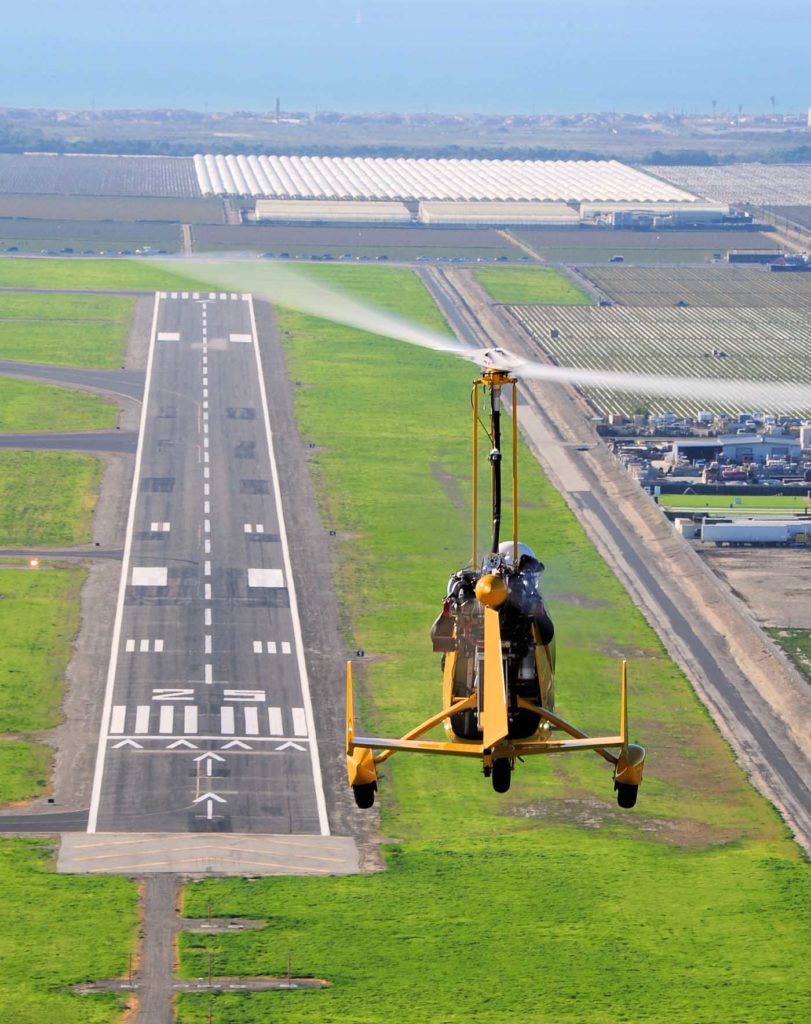
Runway rules
For all of the ways in which a gyroplane flies like a helicopter, it takes off and lands like an airplane. That’s where I was at a disadvantage, because unlike many pilots, I jumped straight into helicopters, without training in airplanes first (or since). So a whole host of runway-oriented concepts were new to me, even things as basic as lining up behind airplanes for takeoff.
Experienced gyroplane pilots often prerotate their rotor systems while taxiing so they’re ready to go as soon as they take the runway. As a novice, this was a bit much for my brain to handle, so Trudell introduced takeoff concepts to me by having me line up on the runway before engaging the prerotator, which is done through a handle on the cyclic that resembles a bicycle brake.

While using my left hand to squeeze the lever near the throttle that keeps the wheel brakes engaged, I would use my right hand to squeeze the prerotator handle, causing a bendix to spin the ring gear located on the rotor hub. As the blades began to turn, a digital display of rotor rpm on the left side of the instrument panel would come alive. When it reached 130, I would slowly bring the cyclic full aft while gradually increasing the throttle.
At 220 rpm, I would release the prerotator and wheel brakes and smoothly increase the throttle to its first stop (5,500 engine rpm) as we began to roll down the runway. When the nose became light, I would slightly decrease the back pressure on the cyclic and balance on the main wheels while steering with the pedals. As the aircraft lifted off the ground, I would pitch forward to a level attitude, accelerate to 65 mph, then raise the nose to establish a climb.

This was the theory, anyway. In practice, I made all the common mistakes: trying to steer during the ground roll with my cyclic instead of my pedals, for example, or tipping back onto the tiny tail wheel while trying to balance on the main gear.
Normal approaches were made with an airspeed of 60 mph on short final. Shortly before the runway, I would reduce the throttle to flare at 10 to 20 feet above the ground, leveling out just above the runway surface before touching down on the main gear. Of course, it took some practice to learn how to time the flare just right for a smooth and controlled touchdown.
We also practiced short field landings — using a slower final approach speed of 50 mph to minimize float before touchdown — and soft field landings, which use a steeper and faster final approach and quicker flare to yield a slower touchdown airspeed, as you would want when landing on a soft surface. These, too, were a coordination exercise that took some time to get the hang of.
But get the hang of it I did — more or less. Unfortunately, it being 2020, I didn’t quite make it to my checkride. First, a head cold (which I’m pretty sure was not coronavirus-related) forced me to cancel a few days of training while I was still on a tight travel schedule. I booked tickets to return to Camarillo to wrap up my training in March, but then Covid-19 struck. Ever since, I’ve been stranded outside the U.S. with no clear idea of when I’ll be back.
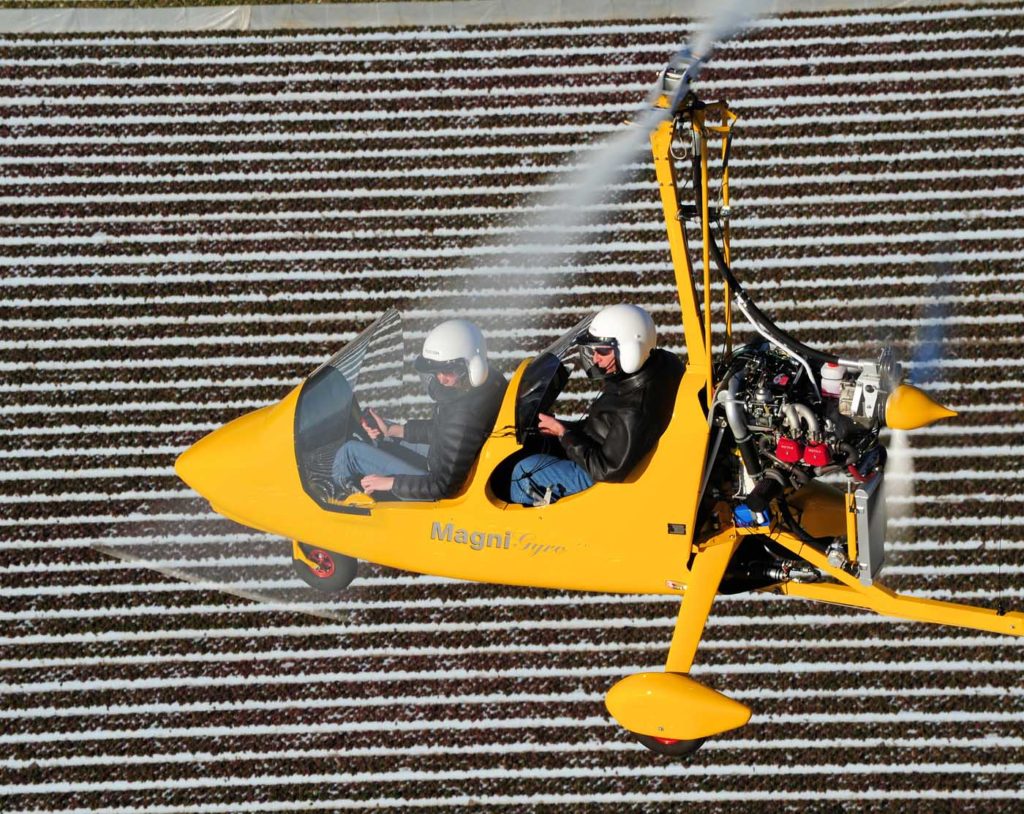
I’ll be back eventually, though, and when I do wrap up my Magni training, it will be a doubly significant milestone: not just another class rating, but a symbol of a post-pandemic return to normalcy. At this time when so many pilots have been forced out of the cockpit altogether, and others are engaged in only critical missions, the prospect of flying for pure pleasure holds a special appeal. And when it comes to flying for the sheer fun of it, it’s hard to beat a gyroplane.






Elan, welcome to gyros! Excellent article. One correction – A gyro’s cyclic is every bit a cyclic. Your light hand pressure on the stick is not directly tilting a 30-foot diameter, 100 pound, 300-RPM rotor through those little control tubes. It’s performing a cyclic pitch adjustment which then acts as a servo, using aerodynamic forces to overcome the huge inertia of the disc to tilt it. Even if you move the stick suddenly, the rotor takes a fraction of a second to comply, which proves you’re not moving it directly. Keep writing, fly safe, and let’s hope this COVID mess stops ruining our fun in 2021!
This is a very well written article. Kudos to the author for wording their experience in a way that proves fruitful to novices and ace rotor pilots alike! I heard of gyroplanes for the first time today, after having come across them in the FAA pilot’s handbook. This piece makes me want to explore the type even further. Many thanks!